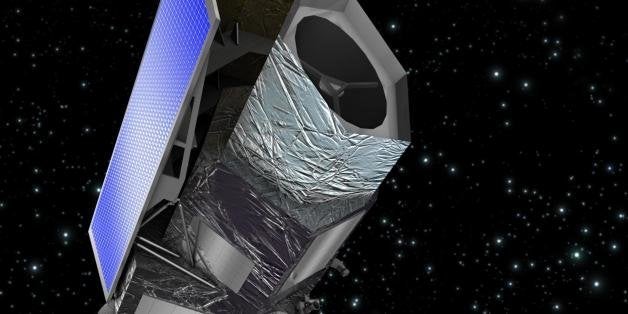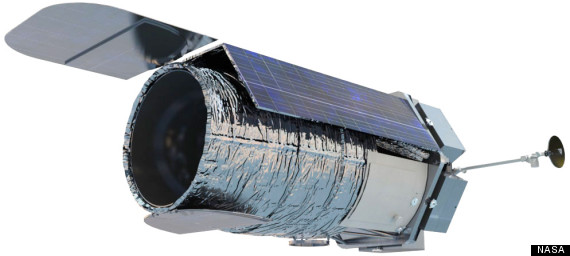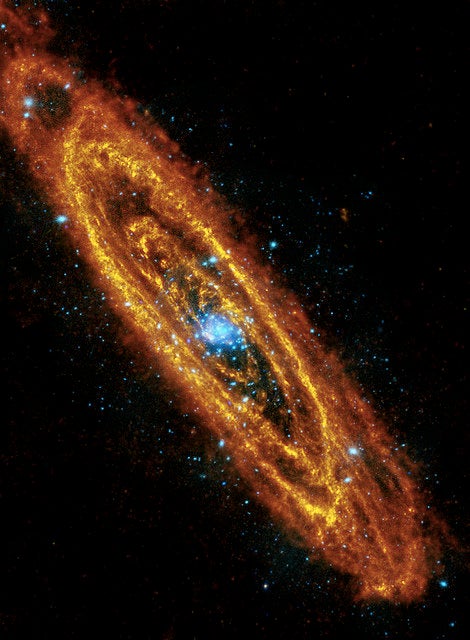
Dark energy makes up nearly three-fourths of the universe, driving its accelerating expansion, but the substance is still mysterious to scientists that study it.
In upcoming years, NASA has plans to investigate this powerful force with the new WFIRST-AFTA mission and a strong role in the European Space Agency's Euclid mission.
"NASA has plans for a robust dark energy portfolio over the next decade," Jason Rhodes of the NASA Jet Propulsion Laboratory said during a news conference at the April meeting of the American Physics Society in Savannah, Georgia. [See amazing photos from a dark energy camera]
'A tripod of science'
NASA's proposed Wide-Field Infrared Survey Telescope-Astrophysics Focused Telescope Assets, or WFIRST-AFTA, will use five probes to perform three complimentary surveys in its search to clarify the nature of dark energy.
"WFIRST-AFTA is a survey mission to make the most precise measurements on the influence of dark energy and dark matter on the universe," Neil Gehrels, WFIRST project scientist of NASA's Goddard Space Flight Center, told Space.com by email.
Type Ia supernovas are thought to form from the explosion of a white dwarf star. Because these powerful detonations all share similar brightness that can be viewed in distant galaxies, they are regarded as "standard candles" of cosmology. Recording how dim a supernova appears provides an indication of their distance.
WFIRST-AFTA will survey nearly 3,000 Type Ia supernovas to determine how rapidly they are moving away from the Milky Way due to the expansion of the universe. Scientists think dark energy drives this expansion.
"We can trace out how the universe is expanding more rapidly in the current epoch than earlier in the history of the universe and use that to constrain models of dark energy," Gehrels said.

An artist's rendition of the proposed WFIRST-AFTA mission, which will study dark energy, extrasolar planets and objects in the near-infrared.
The telescope will also perform a High Latitude Imaging Survey to determine the effects of dark matter structures on the light from distant galaxies. Einstein predicted — and scientists have subsequently confirmed—that massive structures bend the light coming from objects behind them, serving as a gravitational lens. Astronomers have used such natural telescopes formed by features such as massive galaxies to study objects throughout the universe.
Dark matter works the same way, bending the light from galaxies that sit behind it. By searching for small distortions of galactic shapes, WFIRST-AFTA will allow scientists to determine the dark matter distribution along the lines of sight.
The third dark energy survey planned for WFIRST-AFTA will study baryonic acoustic oscillations, or BAOs. Ripples of sound waves left over from the early universe grew into the larger structures of the universe over time. Accurately measuring the position and distance of a hundred million galaxies will map these disturbances to determine the evolution of dark energy over time.
The three complimentary surveys combine to provide a broad portrait of dark energy.
"The combined power of all these probes will give the best understanding of dark energy in the current universe and how it evolved with time as the universe expanded," Gehrels said. "WFIRST-AFTA is the only observatory, space or ground based, that combines all of these probes."
Proposed to launch in the mid-2020s, WFIRST-AFTA is not searching solely for information about dark energy. Instead, it combines what Gehrels calls "a tripod of science." The telescope will also image planets outside the solar system and perform near-infrared surveys.
Euclid
In addition to its own mission, NASA will participate in the European Space Agency's Euclid mission. Last year, NASA nominated 40 American scientists to join the 14 American scientists already part of the international Euclid Consortium, the team responsible for the science, data production and instruments for the mission. NASA will also provide 16 infrared detectors for the telescope.

An artist's view shows three different potential methods of forming Type 1a supernovae, the 'standard candles' used to measure the expansion of the universe. The first two panels show a white dwarf in a binary system accumulating matter from its larger companion. The panel on the right shows two white dwarfs colliding, a possible third scenario.
Euclid's goal is to understand the nature of dark energy and its role in the expansion of the universe. To do so, it plans to use two complimentary probes to study the phenomenon. The first probe will study weak gravitational lensing, while the second will examine BAOs.
Orbiting at the second Lagrangian point, Euclid will use two instruments to study a wide region of the sky free from the contaminating light from the solar system and the galaxy. It will also observe two "Euclid Deep Fields" of the early universe. [8 Baffling Astronomy Mysteries]
Of the approximately 10 billion sources Euclid intends to observe, more than 1 billion will be studied for weak lensing, while tens of millions of galaxies will be measured for clustering caused by BAOs.
"WFIRST-AFTA and Euclid will make complimentary observations, with WFIRST-AFTA observing fainter galaxies and Euclid observing more sky," Gehrels said.
"The combined data set will be much larger and more accurate than any other BAO measurement."
When combined with ground-based observations over a variety of wavelengths, the new observations that WFIRST-AFTA and Euclid will obtain should provide significant insights into dark energy and the expansion of the universe.
"The best constraints on dark energy in the 2020s will come from a combination of Euclid, WFIRST and ground-based data," Rhodes said.
Follow us @Spacedotcom, Facebook and Google+. Original article on Space.com.
